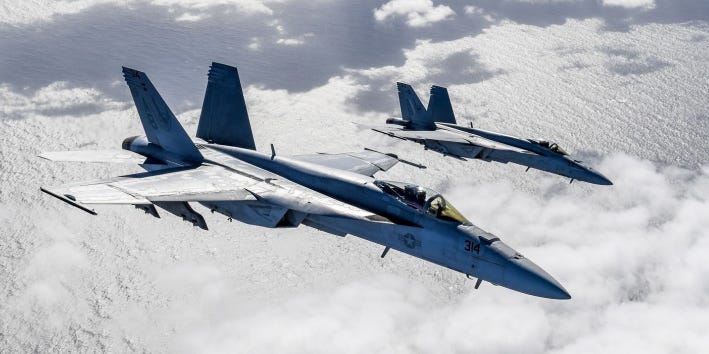
US Navy photo by Chief Mass Communication Specialist Shannon Renfroe
- China’s carrier-based J-15 fighter jets have some advantages over the US Navy’s F/A-18s in air-to-air combat, but the limitations of China’s existing carriers negate them.
- “If you’re talking about the J-15 going up against the F/A-18 at sea, then the F/A-18 is going to destroy the J-15,” a defense expert told Insider.
- But the new carrier that China is building could give the J-15 the opportunity to leverage its advantages, potentially making it more of a threat for US Navy fighters.
- Visit Business Insider’s homepage for more stories.
The Chinese navy’s Shenyang J-15 fighters do not stand much of a chance against the US Navy’s F/A-18s today, but that may not always be the case, especially as China builds a better aircraft carrier, experts told Insider.
China has the world’s largest navy, according to the Pentagon’s latest assessment, and it continues to grow. In recent years, the country has managed to field two aircraft carriers, the Liaoning and the Shandong, both of which carry complements of Shenyang J-15 “Flying Shark” fighter jets.
The Soviet-style carriers have air wings consisting of around 20 to 30 J-15 fighter aircraft.
China argues that the J-15 is comparable to the US Navy’s F/A-18, in some cases even possessing advantages over the Navy’s primary carrier-based strike fighter. The J-15 is capable, but if the Chinese carrier fighter went head-to-head with an F/A-18, it would likely get slaughtered, experts said.

ANTHONY WALLACE/AFP via Getty Images
Shenyang Aircraft Corporation’s J-15 is based on an incomplete prototype of the Russian Sukhoi Su-33 carrier-based air-superiority fighter that China acquired from Ukraine and then reverse engineered. As such, it has not always been the most reliable of aircraft.
It also has underpowered engines, but that is not to say it is without positive attributes though.
Compared to the US F/A-18s, both the Hornet and newer Super Hornet, the J-15 is a heavier aircraft able to carry more weapons and fuel, and it can fly higher and faster. "In air-to-air combat, those can be really important factors," Timothy Heath, a RAND Corporation senior defense researcher, told Insider.
The problem is that the J-15 is unable to leverage a lot of its advantages due to the limitations of China's current aircraft carriers.
The Liaoning, the Chinese sister ship of Russia's Admiral Kuznetsov aircraft carrier, is "not very impressive," China experts have told Insider. The ship was originally an unfinished hull of a Soviet heavy aircraft-carrying cruiser that China obtained from Ukraine and refitted. The Liaoning was commissioned into the People's Liberation Army Navy in 2012.
China then built the Shandong, the country's first homegrown aircraft carrier. Although the Shandong, which was commissioned last December, is an improvement over its predecessor, the design is similar to the Liaoning. Particularly, both carriers use ski jump-assisted short take-off launch systems rather than catapults.

AP Photo/Kin Cheung
"With a ski slope configuration, weight becomes your enemy, and the J-15, as a heavy airplane, starts to be the victim of its own design," Heath said.
The J-15 is the heaviest carrier-based fighter in service, and because the fighter jet has to launch under its own power, it can only take off with a fraction of the weapons and fuel it was built to carry, reducing its range and overall combat capability.
The US Navy's F/A-18s, on the other hand, can take off from the carrier with a full load of fuel and weaponry because all US carriers have catapult-assisted take-off.
Then, there's the avionics. "The US aircraft has a superior radar," Heath said. "That's a huge advantage being able to shoot from a very long range because you can see the enemy first. That gives the F/A-18 a big advantage, even over a more nimble and faster aircraft."
"If you're talking about the J-15 going up against the F/A-18 at sea, then the F/A-18 is going to destroy the J-15," he said.
The end result would be the same if US and Chinese aircraft carriers each launched their respective carrier air wings at one another in carrier-to-carrier combat.
US carriers have an air wing roughly twice the size, and they can put that larger combat force of fixed-wing aircraft in the air faster, thanks to the four onboard catapults. Heath said "it would probably be a slaughter if there was an air-to-air battle between aircraft launched from the Liaoning and a Nimitz-class carrier."

Reuters
China is upping its game
"The pace of technological change within China versus the pace of technological change in America ... is one thing that has alarmed a lot of defense watchers," retired Cmdr. Guy Snodgrass, a former naval aviator, told Insider.
"They are able to see a shortfall in their military capability, identify how they want to approach it, and then rapidly develop and then test and subsequently field" new systems, he said.
China is building a new type of aircraft carrier, potentially the country's first modern flattop, that could allow the J-15 to achieve its full potential.
The Pentagon reports that China's new carrier "will be larger and fitted with a catapult launch system," a design that "will enable it to support additional fighter aircraft, fixed-wing early-warning aircraft, and more rapid flight operations and thus extend the reach and effectiveness of its carrier based strike aircraft."

Kin Cheung/AP
With a carrier like that, "you're starting to talk about a potential competitor for a Nimitz," Heath said, explaining that the "catapults would allow the J-15's advantages to come into play."
"Things look promising for the Chinese," he said. "They seem to be rolling out better avionics, better air-to-air missiles. They've got some pretty good missiles that can really cause trouble for US aircraft."
"You can imagine a Chinese carrier with more advanced J-15 variants with more sophisticated avionics, high-quality missiles, maybe 10, 11, 12 missiles loaded on each aircraft, plenty of fuel, good range, good performance," Heath said. "You could see that at that point the US with its F/A-18s might face a real challenge."
The USS Nimitz was commissioned in 1975 and is the first of ten nuclear-powered aircraft carriers in that class. The Navy is building a new class of carriers, starting with USS Gerald R. Ford, that feature advanced systems like electromagnetic catapults designed to increase the rate at which the ship can launch planes. The Navy plans to build at least five Ford-class flattops.
The US Navy is also working to deploy F-35C Lightning II Joint Strike Fighters on its carriers, but these stealth aircraft are not really built for dogfighting. "The US is really banking on the sensor battle, this idea that the US can see first and shoot first to compensate for general limitations on speed and maneuver and weapons load," Heath explained.
For years, there have been rumors that the Chinese are developing a next-generation carrier fighter. For now, China's carrier-based fighter is the J-15, and it's unclear how that aircraft would do against the fifth-generation F-35.
Snodgrass told Insider that the J-15 "could be a very good dogfighter," assuming the pilot was well trained, but a big advantage for the US Navy is that its pilots have more experience.
The former Navy pilot and TOPGUN instructor said that when he fought against Air Force pilots in F-22 Raptors in an F/A-18, he would usually win because he had a lot of experience dogfighting.
"The F-22 pilot was in a better plane but didn't have as much experience," he said. "We're really good at what we do, and we have a lot of practice doing it." He said that US naval aviators assigned to squadrons in the Indo-Pacific have been increasingly attending TOPGUN training.
Snodgrass said that were US and Chinese carrier-based fighters to battle at sea, experience would likely tip the scales in favor of the US even if China could leverage the J-15s strengths. "We're really good at what we do, and we have a lot of practice doing it," he said.
But, there are always other factors in combat that could change the outcome. Fighters could, for example, face a storm of surface-to-air missiles from carrier escort ships. Snodgrass added, "it's all theoretical until the shooting starts."

